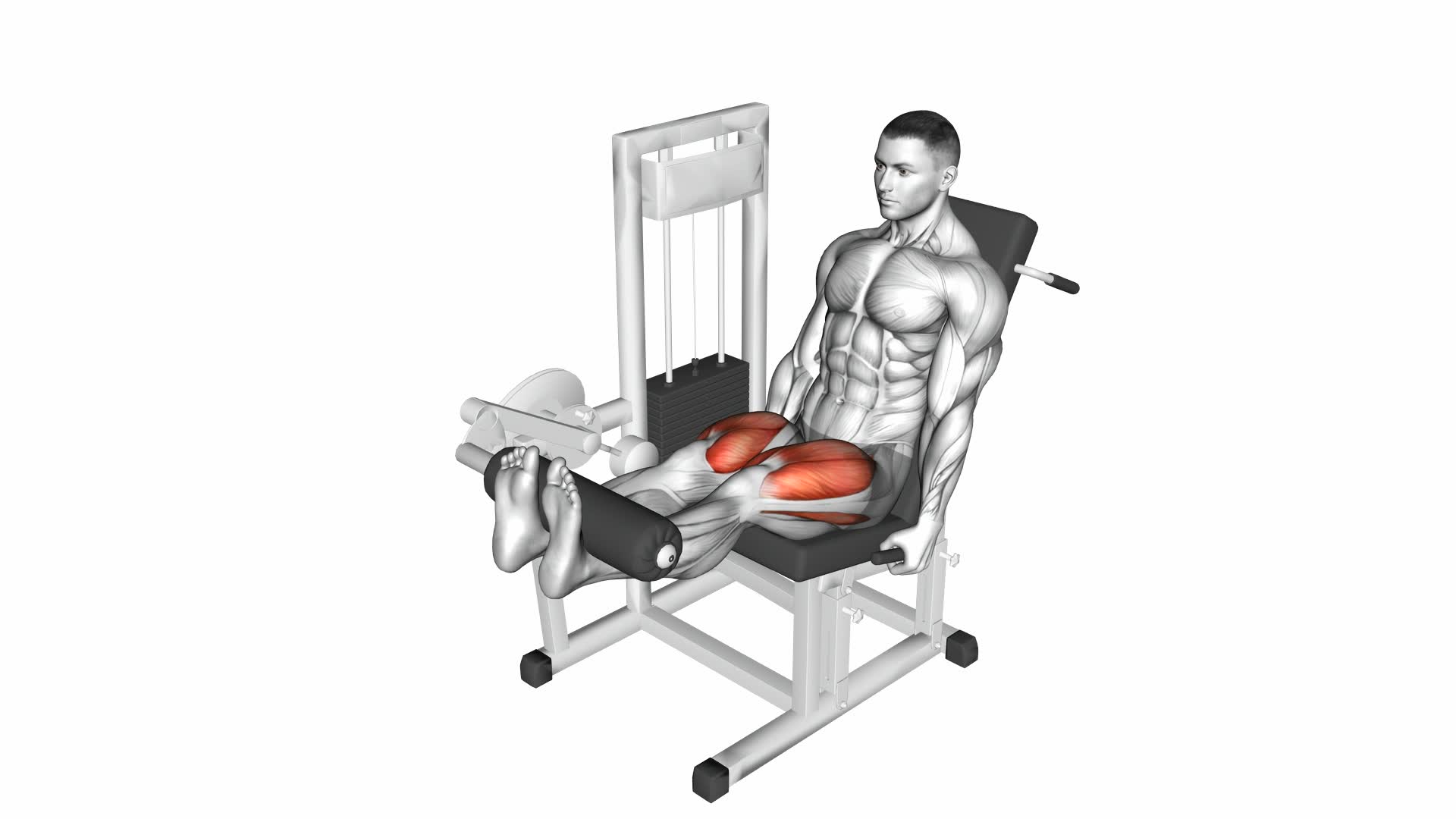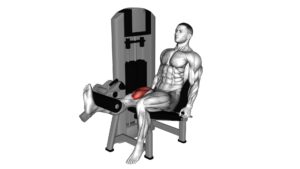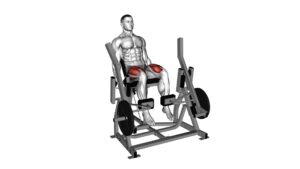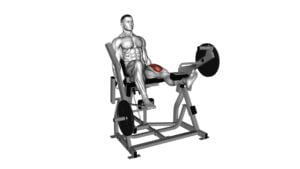Lever Leg Extension – Video Exercise Guide & Tips

Are you looking to strengthen your legs and improve your lower body strength? Look no further than the lever leg extension exercise.
Watch This Exercise Video
In this video exercise guide, we'll show you the proper form and technique, common mistakes to avoid, variations and progressions, and provide tips for a safe and effective workout.
Get ready to take your leg workout to the next level with the lever leg extension.
Let's get started!
Key Takeaways
- Lever leg extension targets quadriceps for improved strength and definition.
- It provides stability to knees, reducing the risk of injuries.
- Lever leg extension enhances lower body strength for activities like running and jumping.
- Proper form and technique, such as maintaining a slight bend in knees and avoiding jerking movements, are crucial for optimal results.
Benefits of Lever Leg Extension
To maximize your leg strength and improve your lower body muscle definition, the lever leg extension exercise is an excellent choice. This exercise specifically targets your quadriceps, the muscles on the front of your thighs, helping to improve their strength and definition. By using a lever machine, you can isolate and target the quadriceps more effectively than with other exercises.
Improving your quadriceps strength is important for various reasons. Strong quadriceps provide stability to your knees, reducing the risk of knee injuries. They also play a significant role in activities that require lower body strength, such as running, jumping, and lifting heavy objects. By incorporating the lever leg extension exercise into your workout routine, you can strengthen your quadriceps and enhance your overall leg strength.
Additionally, the lever leg extension exercise allows you to focus solely on your quadriceps without putting unnecessary strain on your knees. This is particularly beneficial for individuals recovering from knee injuries or those who've weak knees. By strengthening your quadriceps, you can provide better support to your knees and prevent future injuries.
Proper Form and Technique
Now let's focus on achieving proper form and technique for the lever leg extension exercise to ensure maximum effectiveness and safety. Here are some key points to keep in mind:
- Keep your back flat against the backrest throughout the exercise. This will help maintain proper spinal alignment and prevent any unnecessary strain on your lower back.
- Ensure that your knees are properly aligned with the lever pad. Misalignment can lead to improper muscle activation and reduced effectiveness of the exercise.
- Avoid using momentum or jerking movements to lift the weight. Instead, focus on a slow and controlled movement, fully extending your legs and squeezing your quadriceps at the top of the movement.
- Don't lock out your knees at the top of the movement. This can place excessive stress on your knee joints. Instead, maintain a slight bend in your knees throughout the exercise.
When it comes to equipment options, lever leg extension machines are commonly found in most gyms. However, there are also alternative options available, such as resistance bands or ankle weights, which can provide a similar muscle-strengthening effect. It's important to choose the equipment that best suits your needs and abilities.
Common Mistakes to Avoid
Avoid these common mistakes when performing the lever leg extension exercise to ensure optimal results and prevent injuries. Proper form and technique are essential for getting the most out of this exercise while minimizing the risk of injury.
One common error is using momentum to swing the weight up instead of using controlled movements. This not only diminishes the effectiveness of the exercise but also puts unnecessary strain on your joints.
Another mistake to avoid is lifting too heavy of a weight. It's important to choose a weight that challenges you but still allows you to maintain proper form throughout the entire range of motion. Failing to do so can lead to muscle imbalances and increase the risk of injury.
Additionally, it's important to avoid locking your knees at the top of the movement. This can place excessive stress on your knee joints and potentially cause injury. Keep your knees slightly bent at all times to maintain tension in your muscles and protect your joints.
Variations and Progressions
As you progress with the lever leg extension exercise, you can incorporate variations and progressions to further challenge your muscles and enhance your strength and stability. Here are some advanced modifications to try:
- Single-leg lever leg extension: Instead of using both legs, perform the exercise with one leg at a time. This increases the demand on your quadriceps and improves balance.
- Weighted lever leg extension: Hold a dumbbell or ankle weight on your working leg to add resistance and increase the intensity of the exercise.
- Tempo variations: Slow down the movement by taking 3-5 seconds to lift and lower your leg. This places more time under tension on your muscles and enhances muscle growth.
By incorporating these progression variations into your lever leg extension routine, you can continue to challenge your muscles and prevent plateaus in your strength and stability gains. Remember to start with proper form and gradually increase the difficulty as you become more comfortable with each variation.
Now that you have learned about variations and progressions, let's move on to the next section where we'll discuss tips for a safe and effective workout.
Tips for a Safe and Effective Workout
To ensure a safe and effective workout, use proper form and technique while performing the lever leg extension exercise. This exercise primarily targets the quadriceps muscles and can help improve strength and stability in the lower body. Follow these tips to prevent injury and maximize muscle activation.
- Adjust the machine: Before starting the exercise, make sure the lever arm is set at a comfortable height. Your knees should be in line with the machine's pivot point to ensure proper alignment.
- Maintain a neutral spine: Keep your back flat against the seat and avoid arching or rounding your lower back. This helps to stabilize your core and prevent strain on the spine.
- Engage your core: Activate your abdominal muscles throughout the exercise to provide stability and support to your lower back.
- Control the movement: Slowly extend your legs until they're fully straight, focusing on using your quadriceps muscles to perform the movement. Avoid using momentum or swinging your legs.
- Avoid locking your knees: At the top of the movement, don't fully lock your knees. This helps to maintain tension in the muscles and prevents excessive stress on the joint.
Sample Lever Leg Extension Workout Routine
Now, let's talk about the key points to keep in mind when performing a lever leg extension workout routine.
It's crucial to maintain proper form techniques throughout the exercise to prevent injury and maximize effectiveness.
If you're a beginner, there are variations available that can help you ease into the exercise.
Additionally, leg extensions offer various benefits such as strengthening the quadriceps and improving overall lower body strength.
Proper Form Techniques
Start by positioning yourself on the lever leg extension machine with your feet securely placed on the foot pad. To ensure proper form and maximize the effectiveness of your workout routine, keep the following tips in mind:
- Maintain a neutral spine throughout the exercise, avoiding any excessive arching or rounding of the back.
- Keep your core engaged and your shoulders relaxed to prevent unnecessary strain.
- Control the movement by using a slow and controlled tempo, focusing on the contraction of your quadriceps.
Avoid using momentum or swinging your body to lift the weight, as this can lead to improper form and potential injury.
- Avoid fully locking out your knees at the top of the movement to maintain tension on the targeted muscles.
- Don't use excessive weight that compromises your form or puts unnecessary stress on your joints.
Variation for Beginners
To modify the lever leg extension exercise for beginners, try using a lighter weight or decreasing the range of motion. As a beginner, it's important to start with a weight that allows you to perform the exercise with proper form and without straining your muscles. You can also decrease the range of motion by not fully extending your legs or by only extending them partially. This modification can help you build strength gradually and reduce the risk of injury.
Additionally, there are alternative exercises that beginners can consider, such as seated leg extensions or resistance band leg extensions. These exercises can provide similar benefits while allowing you to adjust the intensity to your fitness level.
Now, let's move on to the next section to learn about the benefits of leg extensions.
Benefits of Leg Extensions
Experience the numerous benefits of lever leg extensions with this sample workout routine. Leg extensions not only target and strengthen your quadriceps but also provide several other benefits.
Here are three reasons why you should incorporate leg extensions into your workout routine:
- Increased Quadriceps Strength: Leg extensions isolate and target the quadriceps muscles, helping to build strength and definition in your thighs.
- Improved Knee Stability: Leg extensions can help improve knee stability by strengthening the muscles around the knee joint, reducing the risk of injuries.
- Enhanced Athletic Performance: Strong quadriceps are crucial for activities that involve running, jumping, and squatting. Leg extensions can help improve your overall athletic performance.
To maximize the benefits of leg extensions, it's important to use proper technique. Make sure to adjust the machine to your body size, maintain a controlled movement, and avoid locking your knees at the top of the movement.
Incorporating leg extensions into your workout routine can help you achieve stronger, more stable legs and improve your athletic performance.
Frequently Asked Questions
How Many Sets and Repetitions Should I Do for Lever Leg Extensions?
To improve strength and target your leg muscles effectively, it's important to determine the right sets and repetitions for lever leg extensions.
While the ideal number may vary depending on your fitness level and goals, a good starting point is 3 sets of 10-12 repetitions. This allows for enough volume to stimulate muscle growth and development.
Can Lever Leg Extensions Help Improve My Running or Jumping Ability?
Lever leg extensions can be beneficial for improving running and jumping ability. By targeting the quadriceps muscles, this exercise helps strengthen and tone the legs, which are essential for athletic performance.
However, it's important to perform lever leg extensions correctly to avoid common mistakes. Keep your back flat against the pad, engage your core, and avoid using momentum to lift the weights.
Consistency and proper form are key for maximizing the impact of lever leg extensions on your athletic performance.
Is It Normal to Feel Discomfort or Soreness in My Knees After Doing Lever Leg Extensions?
Feeling discomfort or soreness in your knees after doing lever leg extensions isn't uncommon. It could be due to improper form or technique. Make sure to maintain proper alignment and avoid locking your knees at the top of the movement.
If knee discomfort persists, consider alternatives like seated leg extensions or resistance band exercises. Remember to consult with a professional to address any concerns or issues you may have.
Can I Still Do Lever Leg Extensions if I Have a Knee Injury or Knee Pain?
If you have a knee injury or pain, it's important to be cautious with lever leg extensions. While it's best to consult with a healthcare professional, there are modifications you can try to make the exercise more knee-friendly. These modifications may include reducing the weight or range of motion.
Additionally, there are many other leg exercises that are less strenuous on the knees, such as squats with proper form, lunges, or step-ups.
Are There Any Specific Muscles That Lever Leg Extensions Target?
Lever leg extensions target specific muscles and offer benefits. By performing this exercise, you can activate and strengthen your quadriceps, which are the muscles on the front of your thighs. These muscles play a crucial role in various movements, such as walking, running, and jumping.
Lever leg extensions can help improve muscle tone, increase knee stability, and enhance overall lower body strength. Incorporating this exercise into your routine can support your fitness goals.
Conclusion
In conclusion, the lever leg extension is an effective exercise for targeting the quadriceps muscles. By maintaining proper form and technique, you can maximize its benefits and avoid common mistakes.
Incorporating variations and progressions into your workout routine can help challenge your muscles and promote further strength gains. Remember to always prioritize safety and consult with a fitness professional if needed.
Now you have the knowledge and tools to perform lever leg extensions safely and effectively.

Author
Years ago, the spark of my life’s passion ignited in my mind the moment I stepped into the local gym for the first time. The inaugural bead of perspiration, the initial endeavor, the very first surge of endorphins, and a sense of pride that washed over me post-workout marked the beginning of my deep-seated interest in strength sports, fitness, and sports nutrition. This very curiosity blossomed rapidly into a profound fascination, propelling me to earn a Master’s degree in Physical Education from the Academy of Physical Education in Krakow, followed by a Sports Manager diploma from the Jagiellonian University. My journey of growth led me to gain more specialized qualifications, such as being a certified personal trainer with a focus on sports dietetics, a lifeguard, and an instructor for wellness and corrective gymnastics. Theoretical knowledge paired seamlessly with practical experience, reinforcing my belief that the transformation of individuals under my guidance was also a reflection of my personal growth. This belief holds true even today. Each day, I strive to push the boundaries and explore new realms. These realms gently elevate me to greater heights. The unique combination of passion for my field and the continuous quest for growth fuels my drive to break new ground.







